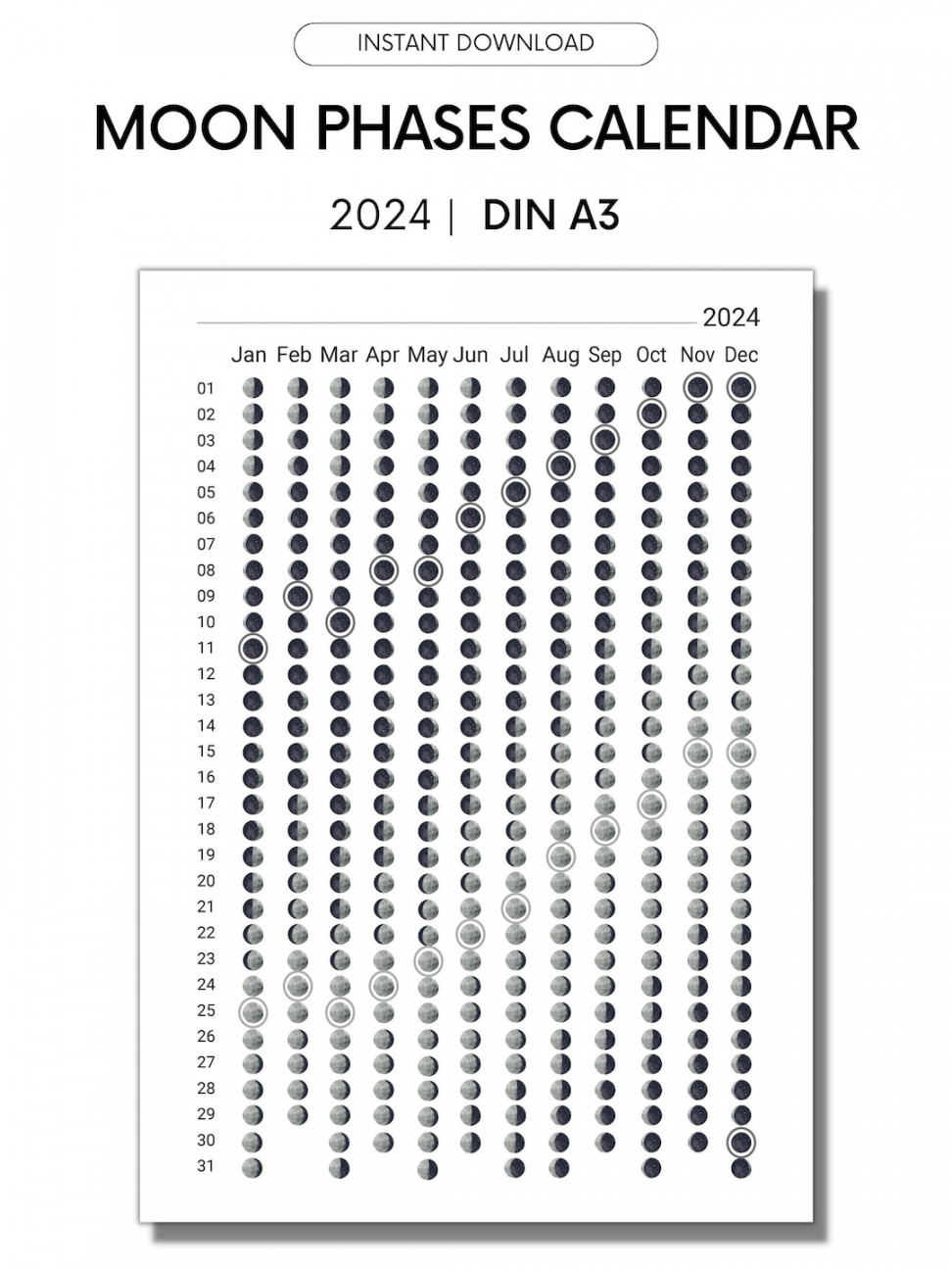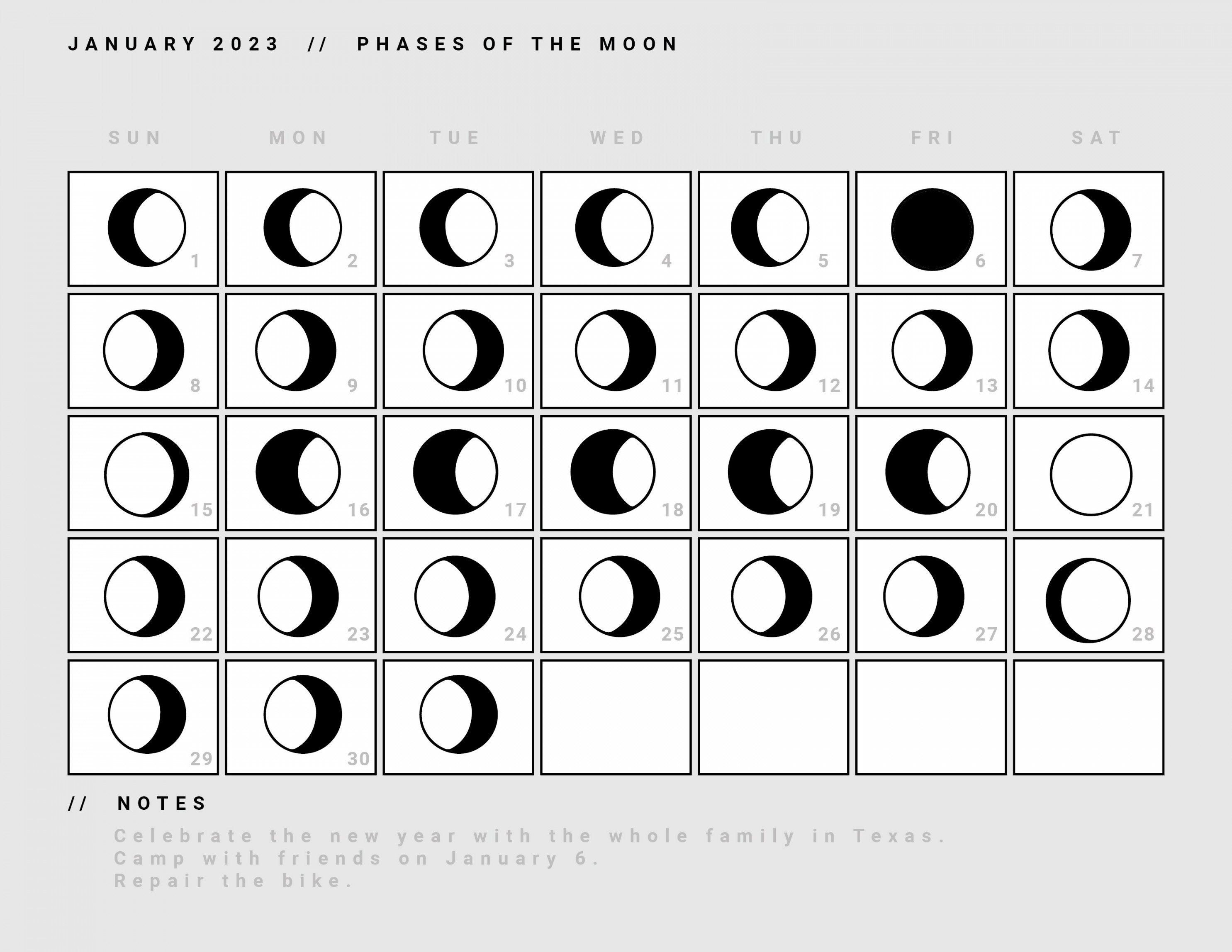Blank Moon Phase Calendar
Moon Phase Calendar 2023
The 2023 Moon Calendar given below charts the different Moon phases in each month. As we click on a date on the Moon phase Calendar, information regarding the lunar phases (ranging from waning Moon and waxing Moon to Full Moon and New Moon), Moonrise and Moonset timings, Moon sign, and the Moon aspects that the Moon forms with other planets on that date come tabulated in brief. This information is subjective to the location set by default. Use the table below to enter the year, the month, and place to get the desired information about the Moon.

New York City, New York, United StatesAmerica/New_York
The table below elucidate the four primary phases of the Moon, each of them refered to as a quarter.

The astrological system elucidates four primary phases of the Moon, each of these phases referred to as a quarter. It also includes four intermediate phases in the waxing and waning period of the cycle.
Date Time Moon Phase November 09 06:43 am Last Quarter 10° Leo 21′ November 16 06:58 pm New Moon 18° Scorpio 18′ (New Beaver Moon) November 23 04:02 pm First Quarter 24° Aquarius 24′ Void-of-course for November, 2023.

The following list provides timings, lunar aspects and positions of the Void-of-Course Moon in the month of November
Start End Last Aspect Position Nov 01, 6:06 pm Nov 02, 3:00 am ☽ ☐ ♆ Moon 25° Gemini 13′ Nov 04, 8:57 am Nov 04, 12:51 pm ☽ ☍ ♇ Moon 28° Cancer 1′ Nov 06, 2:30 pm Nov 07, 1:09 am ☽ △ ☊ Moon 24° Leo 45′ Nov 09, 10:25 am Nov 09, 1:38 pm ☽ ⚹ ☿ Moon 28° Virgo 23′ Nov 11, 8:35 pm Nov 12, 12:09 am ☽ ☐ ♇ Moon 28° Libra 7′ Nov 14, 4:33 am Nov 14, 7:53 am ☽ ⚹ ♇ Moon 28° Scorpio 10′ Nov 16, 4:26 am Nov 16, 1:11 pm ☽ ☐ ♆ Moon 25° Sagittarius 0′ Nov 18, 1:57 pm Nov 18, 4:57 pm ☽ ☌ ♇ Moon 28° Capricorn 14′ Nov 20, 4:19 pm Nov 20, 7:59 pm ☽ ☐ ☉︎ Moon 27° Aquarius 50′ Nov 22, 8:39 pm Nov 22, 10:49 pm ☽ △ ♂ Moon 28° Pisces 43′ Nov 24, 11:10 pm Nov 25, 1:58 am ☽ ☐ ♇ Moon 28° Aries 22′ Nov 27, 3:21 am Nov 27, 6:10 am ☽ △ ♇ Moon 28° Taurus 24′ Nov 29, 6:33 am Nov 29, 12:23 pm ☽ ☍ ☿ Moon 26° Gemini 50′ Lunar Phases, Moonrise and Moonset timings for November 2023.
![]()
Following is a list of different lunar phases, moonrise and moonset timings for each day in the month of November.
Date Phase Moon Rise Moon Set November 01 Waning Gibbous 8:29 pm Nov 02, 12:44 pm November 02 Waning Gibbous 9:26 pm Nov 02, 12:44 pm November 03 Waning Gibbous 10:28 pm Nov 03, 1:30 pm November 04 Waning Gibbous 11:32 pm Nov 04, 2:07 pm November 05 Last Quarter 11:35 pm Nov 05, 1:37 pm November 06 Last Quarter 12:37 am Nov 06, 2:02 pm November 07 Last Quarter 12:37 am Nov 07, 2:23 pm November 08 Last Quarter 1:38 am Nov 08, 2:43 pm November 09 Waning Crescent 2:38 am Nov 09, 3:02 pm November 10 Waning Crescent 3:40 am Nov 10, 3:22 pm November 11 Waning Crescent 4:43 am Nov 11, 3:44 pm November 12 Waning Crescent 5:49 am Nov 12, 4:09 pm November 13 New Moon 6:58 am Nov 13, 4:39 pm November 14 Waxing Crescent 8:09 am Nov 14, 5:17 pm November 15 Waxing Crescent 9:20 am Nov 15, 6:05 pm November 16 Waxing Crescent 10:25 am Nov 16, 7:05 pm November 17 Waxing Crescent 11:20 am Nov 17, 8:14 pm November 18 Waxing Crescent 12:06 pm Nov 18, 9:29 pm November 19 Waxing Crescent 12:42 pm Nov 19, 10:45 pm November 20 First Quarter 1:13 pm Nov 21, 12:00 am November 21 First Quarter 1:38 pm Nov 22, 1:14 am November 22 First Quarter 2:02 pm Nov 23, 2:27 am November 23 Waxing Gibbous 2:26 pm Nov 24, 3:39 am November 24 Waxing Gibbous 2:50 pm Nov 25, 4:53 am November 25 Waxing Gibbous 3:18 pm Nov 26, 6:07 am November 26 Waxing Gibbous 3:50 pm Nov 27, 7:21 am November 27 Full Moon 4:29 pm Nov 28, 8:30 am November 28 Waning Gibbous 5:17 pm Nov 29, 9:31 am November 29 Waning Gibbous 6:12 pm Nov 30, 10:22 am November 30 Waning Gibbous 7:13 pm Dec 01, 11:03 am
As the Moon orbits through its elliptical trajectory, the Earth perceives different lunar phases of the luminary in the course of a month. The Moon goes through different cycles, and the most familiar of them is the New Moon cycle. The New-Moon cycle spans over a period of 29½ days and can be recognized as a cycle between two successive phases of the Moon, starting from one New Moon to the next or one Full Moon to the next. The Moon undergoes these phases, called the lunar phases, owing to its motion around the Earth, which orbits around the Sun. As the Moon progresses a complete cycle about the Earth, the Earth advances only one-thirteenth part around the Sun. As with respect to its motion among the stars, the Moon takes about 27⅓ days to transit through a cycle of the zodiac. This cycle is called the zodiacal cycle of the Moon, where the Moon transits through each of the twelve signs for once.
Phases of the Moon: New Moon Waxing Crescent (Crescent Moon) First Quarter (Waxing Quarter Moon) Waxing Gibbous (Gibbous Moon) Full Moon Waning Gibbous (Disseminating Moon) Third Quarter (Waning Quarter Moon) Waning Crescent (Balsamic Moon)
The New Moon of the lunar phase is when the Sun and the Moon are in the same place or conjunct with each other. The solar and the lunar energies come together and pull in the same direction providing a new thrust for life. The Moon is not visible since it rises with the Sun, and only towards the end of the first quarter does a tiny sliver of the Moon appear right after sunset in the sky. Beginnings come to pass as instinctive or intuitive actions, and everything seems to hide from the light in the darkness of the New Moon.
Towards the end of this quarter, the Sun and the Moon become relatively apart from each other in the geocentric sky. Tiny sliver of the Moon is visible as moves on to the second quarter, and this phase is called the Waxing Crescent (Crescent moon). From the New Moon through the waxing crescent, the first half of the moon becomes visible in the second quarter.
The first quarter of the lunar phase falls halfway between the New Moon and the Full Moon when the Sun and the Moon square each other. The ‘half-Moon’ thus perceived in the west rises around noon, and sets about midnight.
The first quarter further proceeds to expose more of the Moon in what is known as the Waxing Gibbous (Gibbous Moon) phase. This period leads to the Full Moon in a steadily growing light.
The waxing phase, which includes the waxing crescent, the first quarter and waxing gibbous is the time to focus on the completion of things or the time to work on things previously started. The Moon exerts a stronger influence as it moves away from the Sun, until their energies are combined again during the Full Moon when they are opposed to each other. In the steadily growing light of the moon, progress is well underway, and achieving goals and ambitions or completion of incomplete aspects should come easy.
The Full Moon of the lunar phase gives the complete moon, when the Sun and the Moon are in an easy opposition. The Full Moon is observed to rise in the east following sunset, and the Moon rises further up throughout the week. The Full Moon signals the time for completion, when what has begun in the full moon reaches maturity in this phase. The Full Moon shows is the peak of the lunar transitions emanating natural energies, and as they oppose the solar energy at that time, fulfillment becomes the primary objective. The work nearing completion and the effort that went behind it find purpose in this phase.
The Full Moon becomes less exposed to sunlight as it moves from the third phase into what is known as waning phase. The Moon reaches a Waning Gibbous (Disseminating Moon) when the light shed on the Moon disseminates with time.
The Waning Gibbous proceeds to the third quarter of the Moon phase. The third quarter of the lunar phase falls halfway between the Full Moon and the New Moon when the Sun and the Moon, again, square each other. The half-Moon, thus perceived in the east, rises in the later part or the second half of the night. This Moon is called the decreasing Moon that rises first at midnight and stays overhead when the Sun rises.
The third quarter diminishes to Waning Crescent (Balsamic Moon) as it approaches closer to the Sun and later conjuncts with the Sun to give the New Moon.
The waning phase, which includes the waning gibbous, fourth quarter, and waning crescent, is the period of destruction or disintegration when it becomes necessary to eliminate and discard all that is unwanted and weeding on life on Earth. It is the time to get rid of all that is old and past to create room for the new. The light decreases, and darkness takes control. The Moon is dark in the last days of the waning phase, which is nature’s time to relax, refresh, and recuperate. The Moon cycles from light to dark and back to light, a naturally recurring phenomenon.